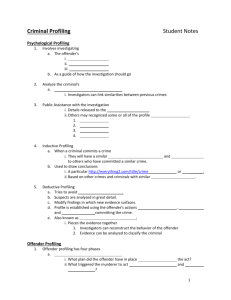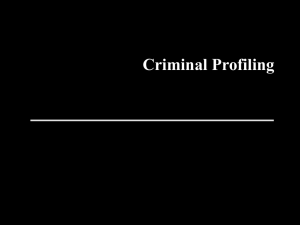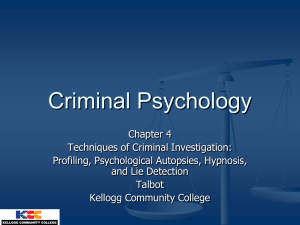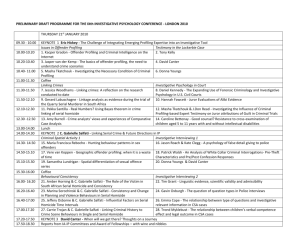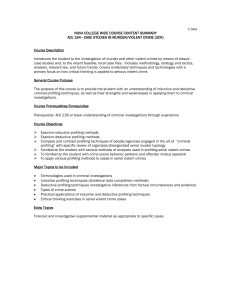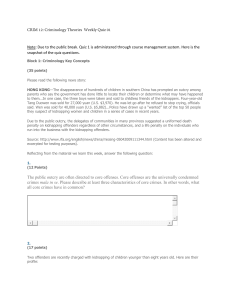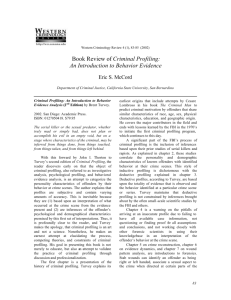multiple choice questions for chapter 3
advertisement
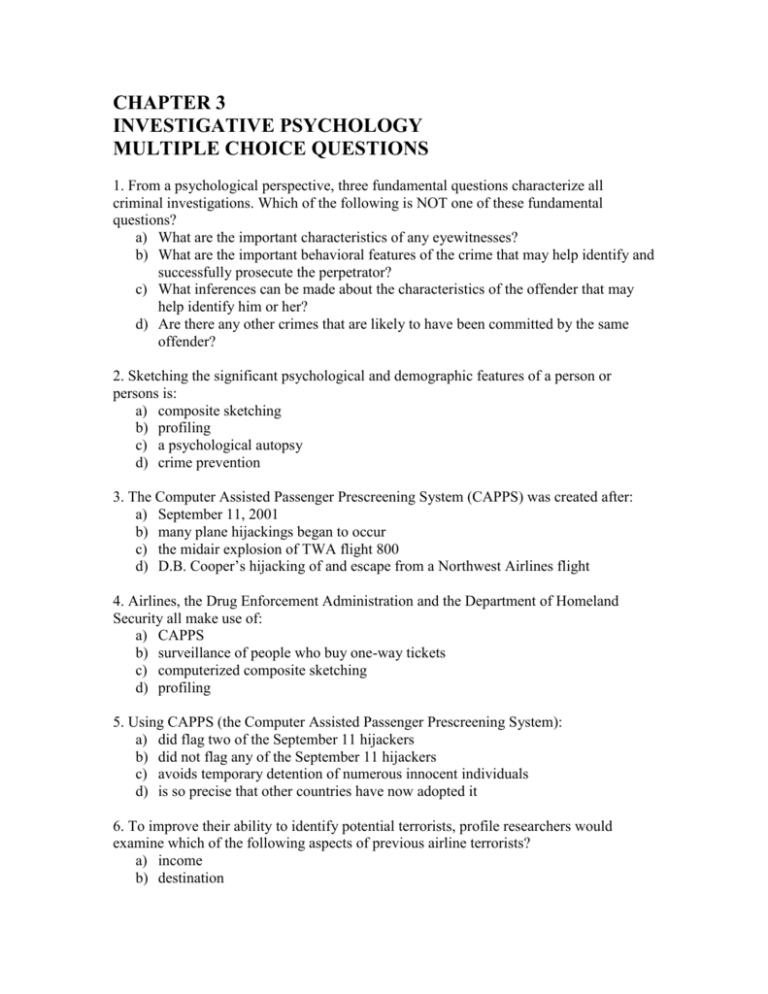
CHAPTER 3 INVESTIGATIVE PSYCHOLOGY MULTIPLE CHOICE QUESTIONS 1. From a psychological perspective, three fundamental questions characterize all criminal investigations. Which of the following is NOT one of these fundamental questions? a) What are the important characteristics of any eyewitnesses? b) What are the important behavioral features of the crime that may help identify and successfully prosecute the perpetrator? c) What inferences can be made about the characteristics of the offender that may help identify him or her? d) Are there any other crimes that are likely to have been committed by the same offender? 2. Sketching the significant psychological and demographic features of a person or persons is: a) composite sketching b) profiling c) a psychological autopsy d) crime prevention 3. The Computer Assisted Passenger Prescreening System (CAPPS) was created after: a) September 11, 2001 b) many plane hijackings began to occur c) the midair explosion of TWA flight 800 d) D.B. Cooper’s hijacking of and escape from a Northwest Airlines flight 4. Airlines, the Drug Enforcement Administration and the Department of Homeland Security all make use of: a) CAPPS b) surveillance of people who buy one-way tickets c) computerized composite sketching d) profiling 5. Using CAPPS (the Computer Assisted Passenger Prescreening System): a) did flag two of the September 11 hijackers b) did not flag any of the September 11 hijackers c) avoids temporary detention of numerous innocent individuals d) is so precise that other countries have now adopted it 6. To improve their ability to identify potential terrorists, profile researchers would examine which of the following aspects of previous airline terrorists? a) income b) destination c) cultural and social backgrounds d) employment 7. A notable aspect of D.B. Cooper’s hijacking of a Northwest Airlines Boeing 727 is that: a) he was never found after parachuting out of the plane b) the bomb he carried exploded without injury to other passengers c) profiling led to his speedy apprehension d) the hijacked flight made it safely into Mexican airspace before he parachuted out of the plane 8. Due to the contagion effect, some hijackers after D.B. Cooper asked for parachutes, but none actually: a) survived the jump b) attempted to jump c) successfully escaped after jumping d) were successful in obtaining money during the hijacking 9. Not long after the hijacking by D.B. Cooper, the FAA required searching or denying boarding to passengers who fit a certain profile. This profile eventually was recognized as inadequate and incomplete because: a) it was repeatedly challenged as unconstitutional b) cultural, social, and security forces are always in a state of flux c) it was not helpful, even from the beginning of its use d) it was constantly being revised 10. Psychiatrist David Hubbard’s skyjacking profile: a) was dogmatic and offensive b) identified hijackers as weak, longtime losers c) was never established as valid by systematic empirical research d) was based on valid research 11. Profiling is: a) well accepted and widely used b) used comfortably and frequently by most police psychologists c) not a frequent investigative activity of police psychologists d) not questioned by any police psychologists 12. The primary goal of criminal profiling is: a) to identify the actual perpetrator of a crime b) to identify demographic factors of victims c) to predict subsequent crime d) to narrow the field of possible suspects within a population 13. To a very large extent, the profiling process: a) is dictated by the quality of the data collected on previous offenders who have committed similar crimes b) is extremely effective in narrowing the field of possible suspects to a single individual c) if done competently can identify a suspect, but not provide statistical probabilities d) is best at predicting future crime, but fails in narrowing a field of possible suspects to a reasonable number 14. The text refers to criminal profiling as: a) a behavioral sketch of an individual who may or may not be a suspected offender b) identifying and describing essential information about a suspected offender c) developing a rough behavioral or psychological sketch of an offender based on clues identified at the crime scene d) weaker than psychological profiling 15. The text refers to psychological profiling as: a) a behavioral sketch of an individual who may or may not be a suspected offender b) identifying and describing essential information about a suspected offender c) developing a rough behavioral or psychological sketch of an offender based on clues identified at the crime scene d) weaker than criminal profiling 16. The text refers to criminal investigative analysis and crime scene investigation as: a) a behavioral sketch of an individual who may or may not be a suspected offender b) identifying and describing essential information about a suspected offender c) developing a rough behavioral or psychological sketch of an offender based on clues identified at the crime scene d) being weaker than criminal and psychological profiling 17. Psychological profiling has been in use: a) only since World War II b) only since serial homicide was first investigated c) informally, for over 100 years d) since it was first used by the FBI in 1971 18. Criminal profiling has gained popularity in law enforcement circles: a) only since World War II b) only since serial homicide was first investigated c) for hundreds of years d) since it was first used by the FBI in 1971 19. TV shows such as CSI: Crime Scene Investigation depict criminal profiling: a) accurately in terms of actual success rates b) as more successful than it is in reality c) as less sophisticated than it is in reality d) as lower in terms of actual success rates 20. If the number of actual success stories in profiling is compared to the total number of misses or failures, the ratio of hits to misses: a) is extremely high b) is about 50/50 c) might be close to chance d) clearly validates the usefulness of profiling 21. Students who aspire to become employed as full-time professional criminal profilers should: a) expect to readily find employment after appropriate training b) expect to find it extremely difficult, if not impossible, to obtain full-time employment in this area c) specialize early on in their training, and network with the many agencies who employ full-time criminal profilers d) look for universities that provide education in the area 22. An area that drastically needs attention from forensic psychologists is: a) the applied aspect of criminal profiling b) criminal profiling c) profiling research d) educating the public regarding criminal profiling 23. Criminal profiling ________ restricted to serial murder and serial sexual assaults. a) is b) should be c) in the future will be d) is not and should not be 24. Computer based profiling: a) may show considerable promise in advancing accuracy b) could never be reliable c) has been shown to be reliable and valid d) reduces the error rate in profiling 25. Risk factors that change over time and situation are called ______ risk factors. a) static b) dynamic c) acute d) stable 26. All of the following could be dynamic risk factors except: a) attitudes b) values c) ethnic background d) beliefs 27. Stable dynamic factors: a) do not change b) change rapidly c) include anger and attitudes about women d) change slowly 28. Acute dynamic factors: a) change rapidly b) do not change c) change slowly d) include anger and attitudes toward women 29. Static factors include all of the following except: a) gender b) attitudes c) biological parents d) birth order 30. Which of the following factors have been shown to be better predictors of the tendency of sex offenders to reoffend? a) static b) stable dynamic c) acute dynamic d) past abuse 31. The MO (modus operandi) that an offender uses to commit a crime successfully can be considered a(n) _________ factor. a) static dynamic b) acute dynamic c) stable dynamic d) macro dynamic 32. An offender’s signature: a) is thought to be related to the unique cognitive processes of the offender b) is relatively inconsistent in its characteristics c) has less stability than the MO d) is a static dynamic factor 33. A symbolic communication by the offender that goes beyond what is necessary to commit the crime is known as a: a) modus operandi b) signature c) static dynamic factor d) criminal communicator 34. A crime scene that suggests planning and premeditation is called a(n) __________ crime scene. a) organized b) disorganized c) mixed d) regulated 35. A crime scene showing that the offender committed the crime without premeditation or planning is called a(n) __________ crime scene. a) organized b) disorganized c) mixed d) unregulated 36. A crime scene showing that the crime began as carefully planned but deteriorated into a chaotic situation is called a(n) ___________ crime scene. a) organized b) disorganized c) mixed d) multi-regulated 37. An offender who kills a victim and then places the body in bed with the head on the pillow, or in a similar natural-looking state is engaged in: a) ritual b) trophy taking c) staging d) undoing 38. An offender who kills a victim and takes something away from the scene is engaged in: a) ritual b) trophy taking c) staging d) undoing 39. Intentional alteration of a crime scene prior to the arrival of the police is: a) ritual b) trophy taking c) staging d) undoing 40. _________ often occurs following an autoerotic asphyxiation. a) Ritual b) Trophy taking c) Staging d) Undoing 41. Postmortem psychological analysis is called a(n): a) victimology b) dead mind reading c) psychological autopsy d) characteristic mapping 42. Deciding whether a death was natural, accidental, a suicide, a homicide, or undetermined is __________. a) the modus operandi b) a psychological autopsy c) determining the manner of death d) profiling 43. The vast majority of psychological autopsies have been done in: a) the United States b) Europe c) Australia d) Canada 44. Psychological autopsies have: a) been found to be categorically conclusive b) not been demonstrated to be highly reliable and valid c) not yet been used by the U.S. Military d) been demonstrated to be highly reliable and valid 45. Poythress et al. (1993) recommended forensic psychologists conducting psychological autopsies not do all of the following, except: a) not use these procedures in nondeath situations b) not make conclusions about the precise mental state or actions of the deceased c) not state an opinion d) not mislead 46. Geographical ________ refers to the analysis of locations associated with the spatial movements of a single serial offender. a) analysis b) profiling c) mapping d) topography 47. Geographical _______ is concerned with analyzing the spatial patterns of crimes committed by numerous offenders over a period of time. a) analysis b) profiling c) mapping d) topography 48. The primary goal of the Criminal Geographic Targeting (CGT) computer program is to: a) take into account known movement patterns of an offender b) determine possible comfort zones of an offender c) hypothesize “hunting patterns” for victims by an offender d) pinpoint the location of an offender’s residence and/or base of operations 49. Serial offenders who commit their crime near their place of residence or neighborhood can be classified as: a) hunters b) poachers c) trollers d) trappers 50. Serial offenders who usually travel some distance from their residence in serach of victims can be classified as: a) hunters b) poachers c) trollers d) trappers 51. Serial offenders who randomly encounter their victims during the course of some activity, rather than by searching for them can be classified as: a) hunters b) poachers c) trollers d) trappers 52. Serial offenders who create situations to draw victims in can be classified as: a) hunters b) poachers c) trollers d) trappers 53. Many professional profilers tend to rely on: a) unsubstantiated assumptions about personality theory b) person by situation interactions in generating behavior c) hard science instead of “gut feelings” d) the power of the situation to influence behavior 54. Ultimately profiling is based on: a) reliable and valid scientific evidence b) the assumption that behavior is consistent across time and place c) the interaction between offender and victim d) the assumption that behavior is inconsistent across time and place 55. _________ behaviors are consistent across both time and place. a) No b) Most c) Some d) All 56. The search for general principles, relationships, and patterns by examining and combining data from many individuals is _________ research. a) situational b) temporal c) nomothetic d) idiographic 57. The intensive study of one individual is ________ research. a) situational b) temporal c) nomothetic d) idiographic 58. Research has continually revealed that __________ research is far more accurate. a) situational b) temporal c) nomothetic d) idiographic 59. The fact that police investigators sometimes select those aspects of a profile that they perceive of as fitting a suspect, while ignoring other aspects that do not seem to fit is an example of ____________. a) the need for profiling b) a confirmation bias c) person by situation interaction d) a suspect bias effect 60. The polygraph: a) detects lies or deception b) has been in use for about 25 years now c) accurately measures and records physiological responses d) is admissible in court 61. For the most part, the major use of polygraph examination is by: a) law enforcement agencies b) defense lawyers c) pre-employment screening by private companies d) pre-employment screening by government agencies 62. Those employed as polygraphers: a) may not have had training in psychology and research b) typically hold doctoral level degrees c) are licensed d) are always graduates of accredited polygraphy schools 63. The most commonly used procedure for lie detection in criminal investigations is the: a) control question technique (CQT) b) relevant/irrelevant question technique (RI) c) computerized polygraph system (CPS) d) countermeasure detection technique (CDT) 64. Detecting countermeasures may be: a) done relatively easily whether they are mental or physical b) relatively easy if they are mental c) done only if they are physical d) relatively easy if they are physical 65. Of the following crimes, which would many professional polygraphers believe might be easiest to detect? a) theft b) burglary c) vandalism d) assault 66. Hypnosis is usually established by: a) an induction procedure b) having the person stand c) having the person avoid focusing on any one thing d) using relaxation medication 67. Which of the following is NOT an important factor in inducing hypnosis? a) the subject’s motivation and desire to cooperate b) subject’s losing awareness of who and where he or she is c) subject’s level of trust in the hypnotist d) subject’s preconceived ideas about hypnosis 68. The one feature of hypnosis that is most troubling to forensic investigators and researchers is the: a) induction procedure b) ethics of using hypnosis c) induced confidence in memories d) fact that it is an altered state 69. Which of the following theoretical perspectives contends that hypnosis is not a special state of consciousness? a) b) c) d) hypnotic trance hypermnesia repression cognitive-behavioral 70. A police officer who is convinced of the powers of hypnosis may: a) inadvertently suggest events, details or behaviors that were not actually details of the crime b) fail to take into account that hypnosis is a special state of consciousness. c) be the single most important person to interrogate a suspect d) not be a good candidate to effectively learn induction procedures 71. Martin Orne became a well known authority on hypnosis as a result of his skillful examination of ____________. a) Jeffrey Dahmer b) Kenneth Bianchi (The Hillside Strangler) c) David Berkowitz (Son of Sam) d) Richard Speck 72. When forensic hypnosis is used as a method to recall events that may be hours or years old, the fundamental assumption is that human memory: a) functions like a videotape b) cannot be altered by suggestion c) cannot be manipulated d) does not make up information 73. Research reveals that the accuracy of facial recognition greatly depends on: a) motivation to recall the face b) the type of face being recalled c) the face not being extremely attractive or unattractive d) the face being average 74. When a person who has been seen in one situation is confused with the face of an offender in another situation, it is called: a) source confusion b) the limits of facial recall effect c) unconscious transference d) unconscious malleability 75. According to the own-race bias: a) people may unconsciously be biased toward their own race, and thus be less motivated to identify the face of an offender of their own racial/ethnic group b) people make the most errors in identifying people from their own ethnic/racial group, because their familiarity with their own group makes them less likely to pay attention to specific facial features c) eyewitnesses can provide the most accurate facial identifications when they are questioned by an investigator of their own racial/ethnic group d) people are much better at discriminating between faces of their own racial/ethnic group than faces of other races or groups of people 76. The differential experience hypothesis explains the own race bias as a result of: a) the greater familiarity individuals have with members of their own race b) frequent casual exposure to those of other races c) outdated racial biases d) the fact that television has resulted in greater familiarity with members of other races 77. The functional size of a lineup is: a) greater the more individuals are in the lineup b) limited to the number of participants who resemble the suspect c) greater if a small number of individuals are in the lineup d) the actual number of participants in the lineup 78. The nominal size of a lineup is: a) the minimum number of participants legally allowed b) limited to the number of participants who resemble the suspect c) greater if a small number of individuals are in the lineup d) the actual number of participants in the lineup 79. When a witness has initially identified a face, even an incorrect one, he or she will be more likely to choose that face again. This is called: a) a commitment bias b) an identification bias c) a confidence bias d) an overconfidence bias 80. A lineup in which police present a single suspect to the eyewitness is: a) illegal b) a show-up c) high in nominal size d) legal as long as the eyewitness is confident 81. The American Psychology-Law Society Lineups White Paper: a) is a training manual b) is a document that outlines the legal rights of eyewitnesses c) was published in an effort to promote ways to improve lineup procedures d) a set of legal standards that must be followed to avoid dismissal of an eyewitness identification by the courts 82. Before viewing a lineup it is recommended that a witness be told that: a) the suspect is in the lineup b) their identification of the suspect is critical c) that the person conducting the lineup knows which one is the actual suspect d) that the suspect may not be in the lineup
